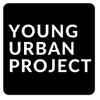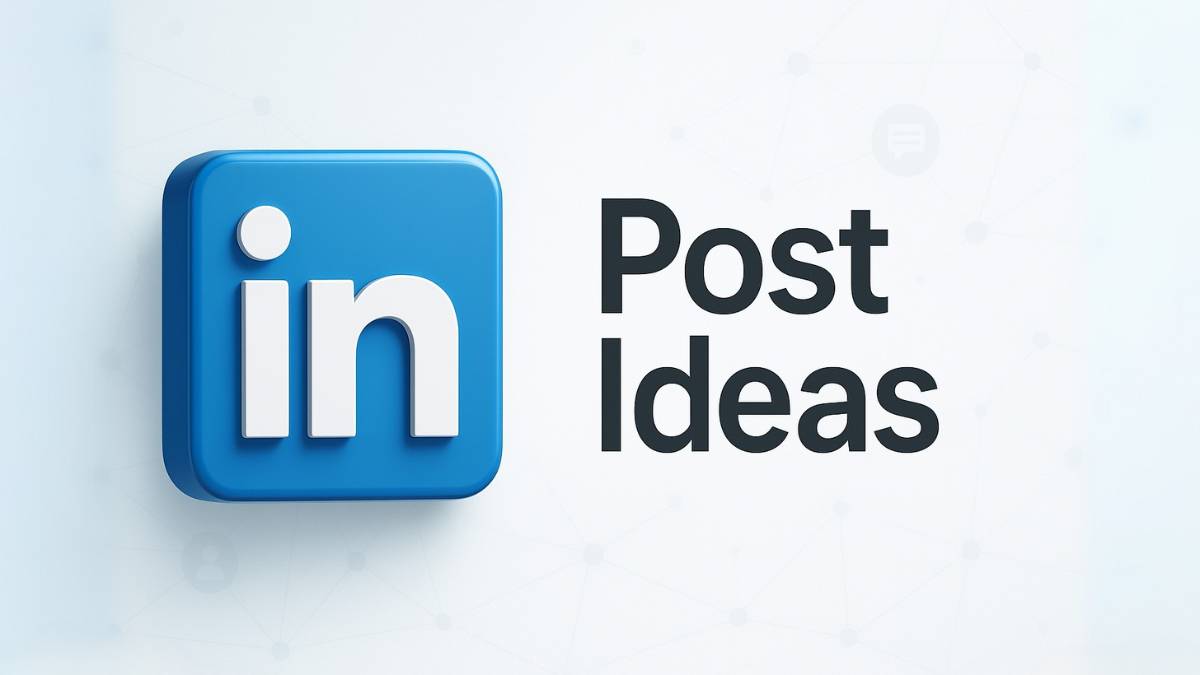Ever stare at the LinkedIn post box wondering, “What the heck should I share today?”
We’ve all been there. And when you’re trying to grow your personal brand, drive business, or just stay relevant on LinkedIn, showing up consistently can feel like a full-time job. The good news? You don’t have to reinvent the wheel every single time.
Table of Contents
Whether you’re a freelancer, marketer, founder, or a working professional looking to build your brand, having a stash of solid, proven LinkedIn post ideas can make the difference between being invisible and unforgettable.
Let’s walk through 30 ideas you can swipe, remix, and run with, all designed to boost visibility, drive engagement, and maybe even land you a few leads.
Why Should You Post on LinkedIn?
LinkedIn isn’t just a place to drop your resume or job hunt anymore. It’s a living, breathing content platform where professionals, founders, and brands are actively sharing stories, insights, and opportunities.
Here’s why it matters:
- LinkedIn has over 1 billion members, and more than 65 million of them are decision-makers. That means your next client, partner, or job opportunity could literally be one post away.
- Unlike Instagram or Facebook, LinkedIn still has strong organic reach, especially for high-value content.
- People actually trust content on LinkedIn more than most platforms. A study by Business Insider even ranked it as the most trusted social platform.
If you’re serious about building credibility, visibility, or authority in your space, posting consistently is non-negotiable.
30 Best LinkedIn Post Ideas to Grow Engagement
Let’s kick off with the first five ideas you can try this week:
1. Break Down a Trending Topic in Your Industry
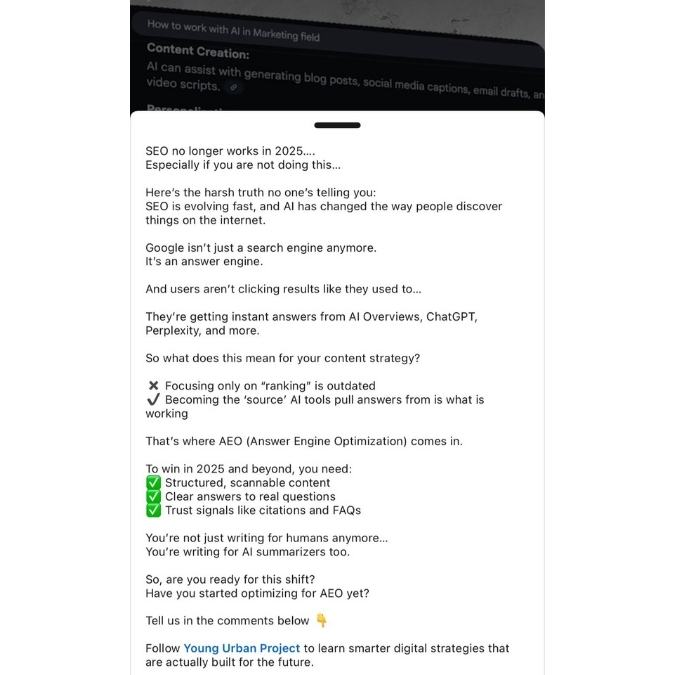
This is one of the fastest ways to tap into momentum. When a hot topic starts circulating, whether it’s a new marketing strategy, tech innovation, or a big change in your niche, jump in early.
But don’t just repost the news. Add your own perspective. What does this change mean for your industry? How might it impact your clients? What should people be watching out for?
Pro Tip: Use a hook like “Here’s what no one’s talking about with [topic]…” to stand out.
Example:
“Everyone’s talking about Google’s latest AI update. But here’s what marketers might be missing, and why your next ad campaign should be thinking two steps ahead.”
2. Showcase a “Before & After” Transformation
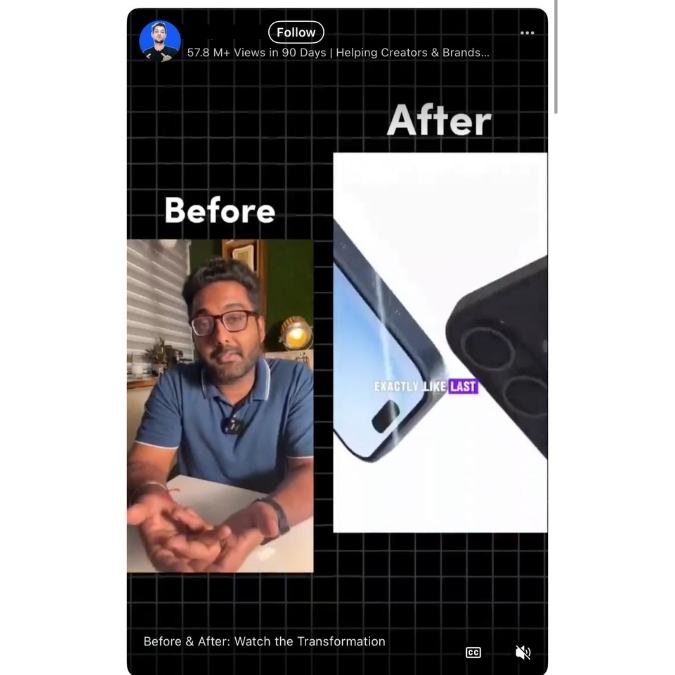
People love stories of change, especially when there’s a clear “wow” moment. This could be:
- A client project you helped turn around
- A business you scaled
- A brand re-design
- Or even your own personal/professional growth
Visuals work great here. Share screenshots, photos, or even stats to show what changed.
Pro Tip: Be honest about the challenges too, that’s what makes the “after” so powerful.
Example:
“6 months ago, this client’s ad account was bleeding money. Today? They’re hitting a 6.2x ROAS consistently. Here’s what we changed.”
3. Post a “Day in the Life” Series
This format is surprisingly effective for building connection. People are curious, they want to know what your workday actually looks like.
You can create a single post or stretch it into a short series. Include:
- Your routine
- Tools you use
- How you plan your day
- Where you work from
- Wins, fails, and lessons
This works well in carousel format or even as a short-form video. It brings a human side to your brand and makes people feel closer to you.
Example:
“A typical Tuesday as a solo marketer: 2 client calls, 1 cold coffee, 3 ads launched, and a mini existential crisis at 3:45 PM. Here’s the full breakdown.”
4. Debunk Common Myths in Your Niche
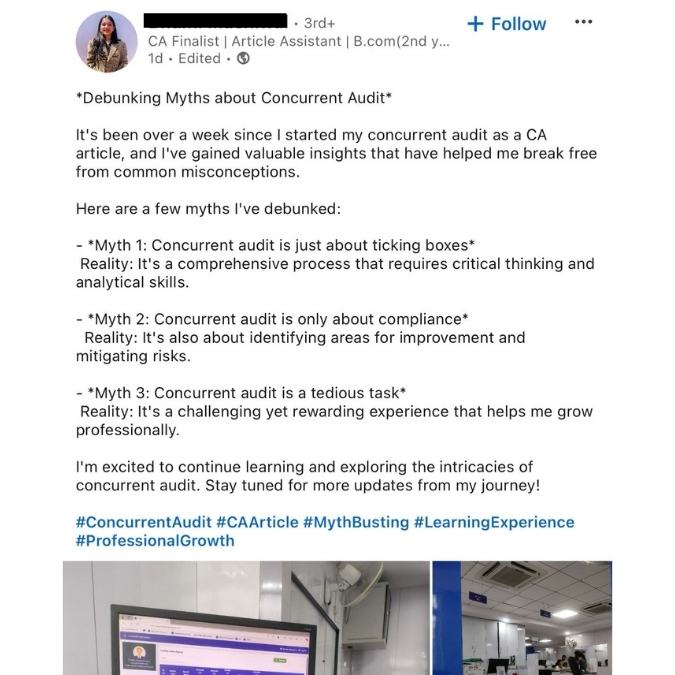
Every industry has its fair share of misconceptions. Find the ones your audience keeps bumping into, and bust them with a smart, no-BS post.
This kind of content gets saved, shared, and commented on because it delivers real clarity and challenges the status quo.
Pro Tip: Start with “You’ve probably heard that…” or “This might surprise you…”
Example:
“You don’t need to run ads to grow your business. Organic content, done right, can drive just as many leads. Here’s how we helped a client scale to ₹10L/month without spending a rupee on paid media.”
5. Share Behind-the-Scenes of Your Process or Tools You Use
People love to peek behind the curtain, especially if they’re trying to learn or do what you do. Share:
- Your tech stack
- Your content planning process
- How you onboard clients
- How you run your weekly planning
These posts position you as an expert, and you’re adding value by showing people how to solve problems or simplify their workflow.
Example:
“Here’s the exact stack I use to manage 7 clients, create content, and keep my sanity (most of the time): Notion + Trello + Slack + Loom. Here’s how I use each tool…”
6. Run a Poll to Know Your Audience Better
Polls are a ridiculously underrated tool for engagement. People love to share their opinions, especially when it’s low-effort, just one click. Plus, LinkedIn’s algorithm tends to push polls more than other formats.
Use polls not just for engagement, but for insight gathering. Want to know what kind of content your audience prefers? What tools they use? Their biggest challenges? Ask them.
Pro Tip: Add a question in the caption that encourages people to explain their vote in the comments.
Example:
Poll: What’s your biggest marketing challenge right now?
a) Generating leads
b) Converting traffic
c) Managing campaigns
d) Staying consistent
Caption: I picked (b), and here’s why… What about you? Drop your reason in the comments, let’s compare notes.
7. Ask a Thought-Provoking Question or Industry Challenge
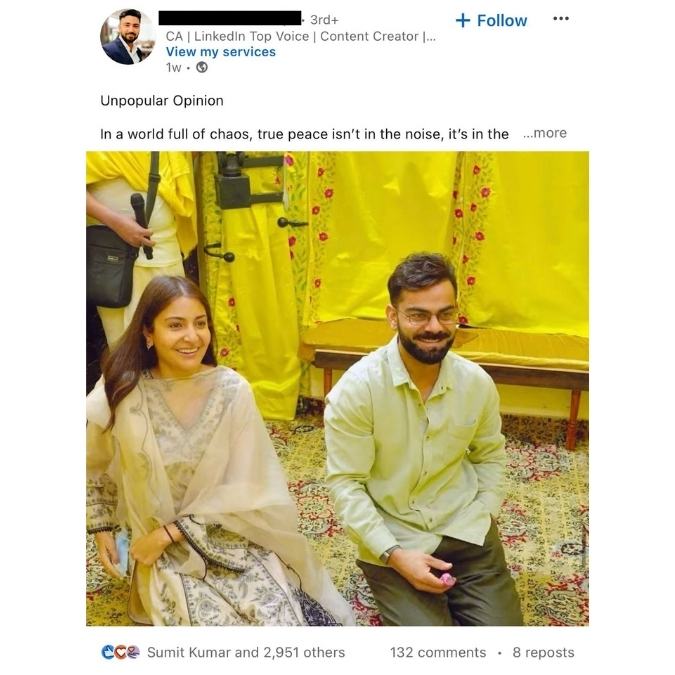
Not every post needs to be a lecture. Sometimes, the best posts are the ones where you ask the question. Especially if it’s a hot take or a challenge most people aren’t talking about.
This is how you start conversations, the kind that rack up comments, saves, and even spark follow-up content. Be bold, curious, and even a little controversial (as long as it’s respectful).
Pro Tip: Use “unpopular opinion” or “real talk” vibes, it often gets people to lean in and respond.
Example:
“Unpopular opinion: Not every founder should be the face of their brand on LinkedIn.
I said what I said.
What do you think, agree or disagree? Would love to hear your take.”
8. Share a Survey, Quiz, or Contest
These posts are great for boosting visibility because they invite participation. They don’t just tell, they ask people to get involved. You can:
- Link to a short Typeform quiz
- Share a quick marketing or mindset test
- Run a giveaway
- Invite followers to share something for a chance to win
Just make sure your audience gets value either way (not just the winner).
Pro Tip: Keep it simple and set a short deadline to create urgency.
Example:
“🚨 QUIZ TIME 🚨
What type of marketer are you?
A. The Data Nerd
B. The Creative Spark
C. The Hustler
D. The Strategist
Drop your letter in the comments and I’ll reply with a 1-line prediction about your marketing style. Let’s go!”
9. Announce Product Launches or Feature Updates
Got something new in the works? Shout about it. Whether it’s a new product, feature, service, or digital freebie, LinkedIn is the perfect place to launch it with context.
Don’t just say “Hey, this is live!”, show why it matters. Share the story behind the feature, the problem it solves, and who it’s for. Use screenshots, demo videos, or even a carousel to break it down.
Pro Tip: Let people know how to get access, and encourage questions in the comments.
Example:
“🎉 New Launch!
We just rolled out a feature that lets you track email campaign ROI without leaving your dashboard.
Took us 3 months, 4 broken dashboards, and a lot of user feedback to get here.
Want early access? Drop a ‘🚀’ and I’ll DM you the link.”
Also Read: Creative Product Launch Ideas
10. Promote Your Upcoming Webinar, Event, or Workshop
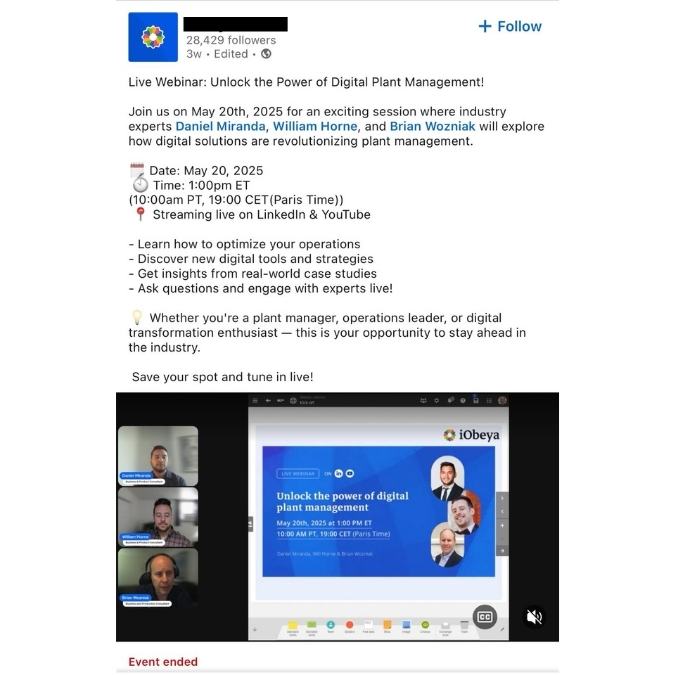
If you’re hosting an event, don’t wait until the last minute to talk about it. Use LinkedIn to drip content before the big day, share what attendees will learn, why it matters, and who it’s for.
Break it up across posts:
- One teaser or countdown
- One with key takeaways
- One with testimonials or past feedback
- One CTA reminder a day before
Pro Tip: Use visuals like posters, speaker reels, or countdown carousels to grab attention.
Example:
“🚨 Free Workshop Alert
Learn how to build a content system that attracts leads while you sleep.
🗓️ Date: May 25
🕐 Time: 7 PM IST
🎯 Format: Live + Q&A
We’re capping it at 100 seats. Drop a ‘📩’ below and I’ll send you the link to register.”
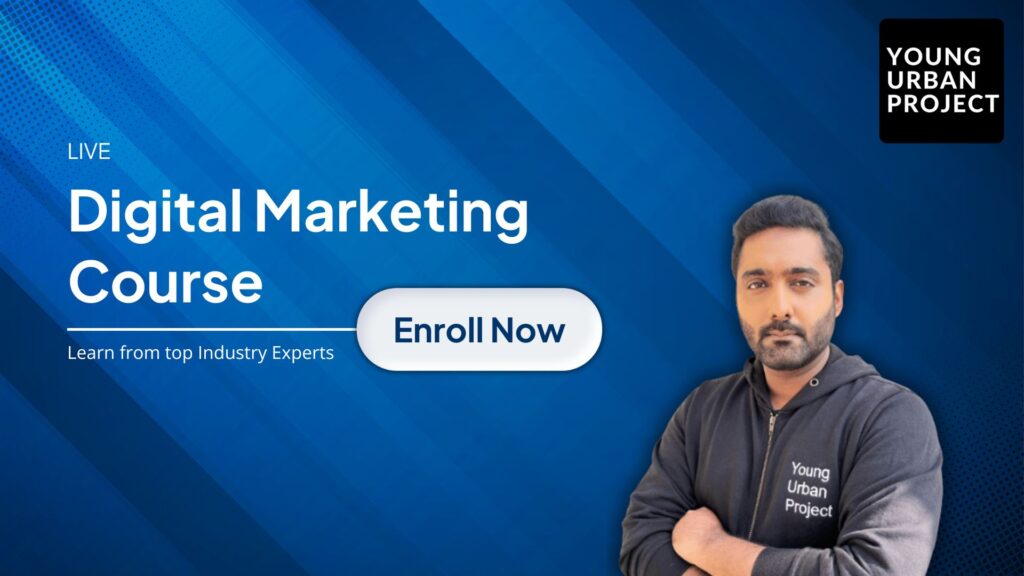
Enroll Now: Live Digital Marketing Course
11. Highlight Company Wins, Milestones, or Culture Moments
People don’t just buy from brands. They buy into stories, missions, and people. Sharing company wins and milestones builds trust, but even better when it’s not braggy.
Make it personal. Share the struggle, the team behind it, or what you learned along the way. Even small wins (like a first client, a remote team meetup, or launching a new landing page) are worth celebrating.
Pro Tip: Tag teammates, add behind-the-scenes photos, and share what the win means to your mission.
Example:
“We just hit our 50th client project 🎉
What started as a two-person freelance gig in a tiny apartment has now turned into a full-blown digital studio.
Grateful. Tired. And more motivated than ever.”
12. Share Job Openings or Career Opportunities
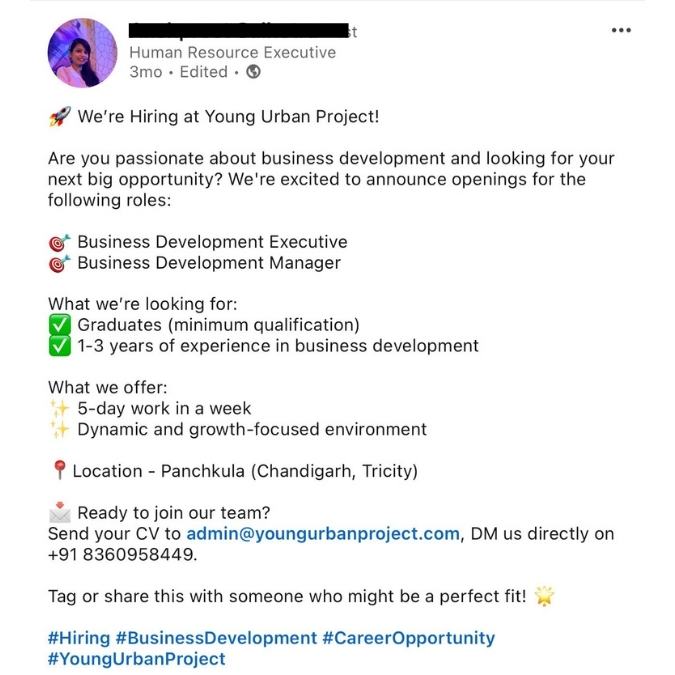
If you’re hiring, LinkedIn is the first place to talk about it, but please, go beyond just copy-pasting a JD. Use your post to sell the vibe of your company as much as the role itself.
Highlight what makes your workplace different. Is it remote-first? Are you flexible with hours? Do you invest in learning? Give a real glimpse of what it’s like to work with your team.
Pro Tip: Share a short story or quote from a current team member to give it some heart.
Example:
“🚨 We’re hiring a Content Marketer!
Not just someone who knows SEO, we’re looking for a storyteller who gets humans.
We’re a fully remote team spread across 3 time zones. Flexible hours. Monthly learning credits. Zero micromanagement.
If that sounds like your vibe, drop a comment or DM me for the link 👇”
13. Shine a Light on Team Members or Leadership Stories
People connect with people, not logos. Use LinkedIn to showcase your team members or leadership. Tell their stories, their wins, their quirky rituals.
It could be:
- A team member’s work anniversary
- Someone overcoming a tough challenge
- A “meet the team” intro series
- A founder’s raw behind-the-scenes journey
Pro Tip: Let them write the post in their own words, or at least include a quote from them.
Example:
“From intern to project lead in under a year
Meet Nisha, she joined us straight out of college, full of questions and Google Docs.
Fast-forward 12 months, and she’s leading client strategy for 5 active campaigns.
Her growth has been insane, and we couldn’t be more proud.”
14. Feature a Customer Story or Testimonial
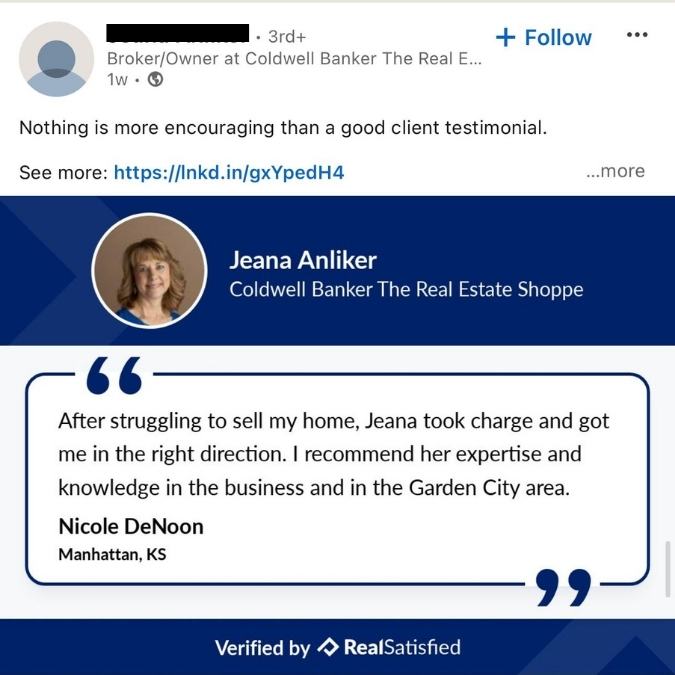
Your customers are your best marketers. Turn their wins into scroll-stopping content. But again, skip the generic testimonial. Make it a story. What was their struggle before? What changed after working with you?
Include quotes, visuals (if allowed), or even short interviews to build credibility and emotional resonance.
Pro Tip: Focus on transformation more than features. Think before/after > product specs.
Example:
“When Priya first joined our cohort, she had no idea how to run a Facebook ad.
Two months later, she’d launched 3 campaigns and booked 9 client calls, all from cold traffic.
Real results from real effort. Shoutout to Priya for showing up and doing the work 💪”
15. Share Media Mentions or Collaborations
Got featured in a publication? Partnered with another brand or creator? That’s not just a credibility flex, it’s a trust signal. Share it!
But make it more than a humblebrag. Tell the story behind it. How did the collab happen? What did you learn? Why does it matter for your audience?
Pro Tip: Tag the publication or collaborator to increase reach, and don’t forget to thank them.
Example:
“Super pumped to be featured in YourStory this week!
I shared how we turned our side hustle into a full-service digital studio in 18 months, without outside funding or fancy offices.
If you’ve ever doubted the ‘start small’ approach, this one’s for you. Link in comments 👇”
16. Write Short LinkedIn Articles (or Long-Form Posts)
Sometimes, 300 words just isn’t enough. When you’ve got a deep idea to unpack, maybe a framework, guide, or opinion piece, LinkedIn Articles (or long-form posts) are perfect.
You can use these to:
- Share strategies that actually work
- Teach a process in detail
- Break down case studies
- Dive into industry trends
Pro Tip: Start with a bold hook. Add clear section headers. End with a strong CTA or ask.
Example:
“Why 90% of founders burn out in year 2, and how to avoid it.
Just dropped a new article where I share the 3 most common mistakes I made building my first agency, and what I’d do differently if I could start over.
Link in first comment.”
17. Repurpose Blog Posts, Podcasts, or Webinars
Creating once and distributing forever, that’s the content creator’s cheat code. If you’ve written a blog, recorded a podcast, or hosted a webinar, don’t let that content sit idle.
Summarize the key takeaways into a carousel, thread, or punchy post. Add a fresh angle or hook, and always link to the original at the end.
Pro Tip: Make the first 2 lines valuable even without the click. Think snackable first, then scalable.
Example:
“Missed our recent webinar on landing B2B clients using content marketing?
No worries, here are 5 killer takeaways you can apply today:
- Sell the problem, not the process
- Case studies > cold DMs
- LinkedIn > Email (yes, really)
…
Full replay link in the comments.”
18. Post a Step-by-Step Tutorial or Checklist
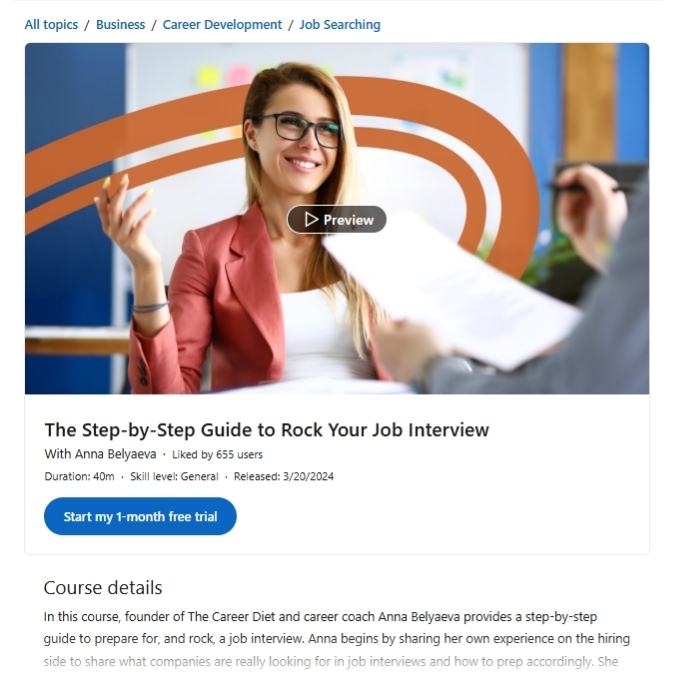
Want to build authority and get saved/shared? This is the post format for you. Whether it’s “How to write a cold email” or “5 things to check before publishing a landing page”, breaking things into clear steps positions you as someone who gets results.
Use emojis, bullet points, or even a carousel to make it super readable.
Pro Tip: End the post with “Save this for later”, it subtly encourages that save button tap (which boosts reach too).
Example:
“How to Write a High-Converting LinkedIn Post (checklist):
- Start with a scroll-stopping hook
- Use 2-3 line paragraphs for breathing space
- Tell a personal or relatable story
- Add 1 clear CTA
- Use 3 – 5 relevant hashtags
Save this for your next post”
Also Read: Become a Freelance Copywriter – Step by Step Guide
19. Publish Data, Case Studies, or Original Research
Numbers tell stories too, and on LinkedIn, they stop the scroll. Whether it’s performance data, campaign results, or original research, sharing stats adds serious credibility.
You don’t need to be a data scientist. Even something as simple as “What happened after 30 days of posting daily?” can work. Break it down visually with graphs or infographics to make it digestible.
Pro Tip: Share the “so what”, tell people what to do with the data, not just what it says.
Example:
“Case Study: How we scaled a D2C brand from ₹2L to ₹15L/month in 90 days
- CTR jumped from 1.3% → 3.7%
- CAC dropped by 42%
- Email flows brought in 28% of total revenue
Full breakdown (with screenshots) in the comments 👇”
Also Read: Tata Motors Case Study: Strategy & Growth
20. Share Book Summaries or Takeaways from a Course
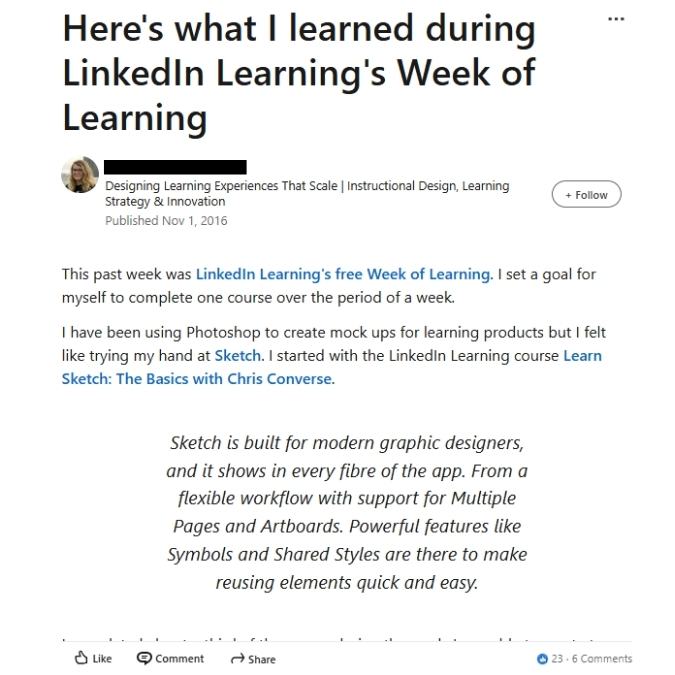
Reading something great? Took a course recently? Don’t keep that gold to yourself. Turn it into a summary post that adds value to your niche audience.
This builds your thought leadership and shows you’re investing in growth (which people respect). Bonus points if you relate the learnings to real-life examples.
Pro Tip: Highlight “5 Takeaways” or “Top 3 Lessons”, easily skimmable formats perform better.
Example:
“Just finished ‘$100M Offers’ by Alex Hormozi.
Here are 5 lessons that changed how I think about pricing:
- People don’t buy products. They buy outcomes.
- The more painful the problem, the more they’ll pay…
Definitely a must-read for anyone selling services online. 📚”
21. Post Short-Form Videos (Tips, Tools, BTS, Vlogs)
Video = eyeballs. Especially short, punchy ones under 90 seconds. Share quick tips, marketing hacks, a behind-the-scenes vlog, or even a quick rant (those work surprisingly well).
Make sure to hook your audience in the first 3 seconds, and always use captions, most people scroll with the sound off.
Pro Tip: Use native uploads instead of YouTube links, LinkedIn favors native content in reach.
Example:
“🎥 60-second tip for creators:
Want your carousels to actually get engagement?
Start with a bold question slide.
Then promise a result.
Then break it into steps.
I show my exact process in this quick vid 👇”
22. Create Eye-Catching Carousel Posts
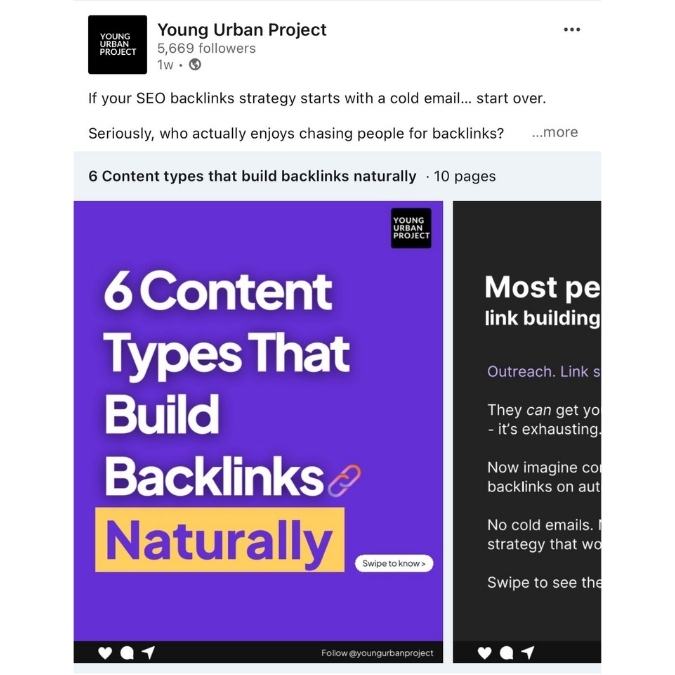
Carousels are 🔥 on LinkedIn right now, especially when they teach something. Use them to explain frameworks, break down a process, or share a checklist.
Design matters, but value comes first. Your first slide = the hook. Every slide after = keep them swiping.
Pro Tip: Use big fonts, lots of space, and bold headlines on each slide. Think “Instagram post meets PowerPoint.”
Example:
“📊 7-Step LinkedIn Funnel You Can Set Up in 1 Week
Slide 1: The Hook
Slide 2: Awareness Post
Slide 3: Value Carousel
Slide 4: Lead Magnet CTA
Slide 5: DM Funnel
Slide 6: Soft Pitch
Slide 7: Analytics & Optimization
Save this one if you’re building your brand this quarter.”
23. Use Visual Quotes or Relatable Memes (Tastefully)
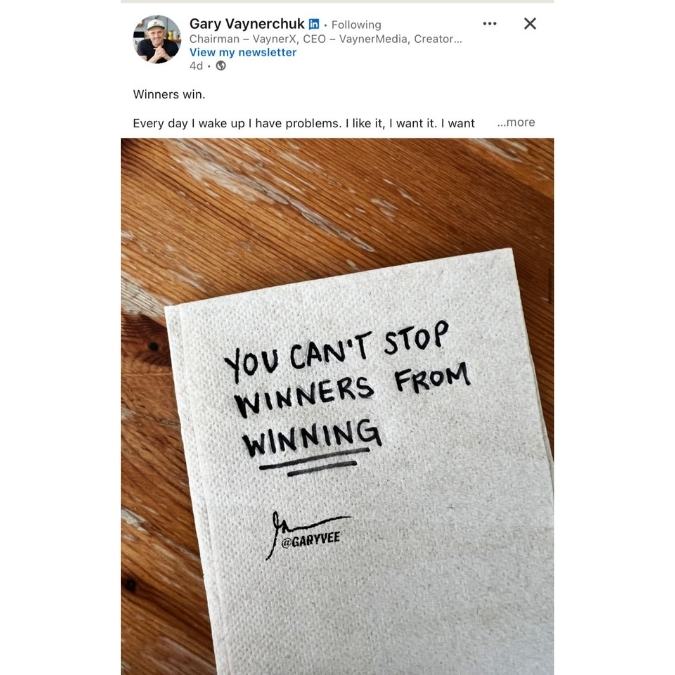
You don’t have to be serious all the time. Smart, well-timed quotes or memes can break the monotony and tap into the emotional or humorous side of your audience.
But, and this is key, keep it tasteful. Stay relevant to your niche and use original formats when possible.
Pro Tip: Pair it with a short caption that adds a little context or personal insight.
Example:
[Image: “Your content won’t always go viral. Post anyway.”]
Caption: “Real talk: My last post flopped.
But 1 person messaged me saying it helped them finally launch their funnel. That’s a win.”
24. Give an Office Tour or Workspace Reveal
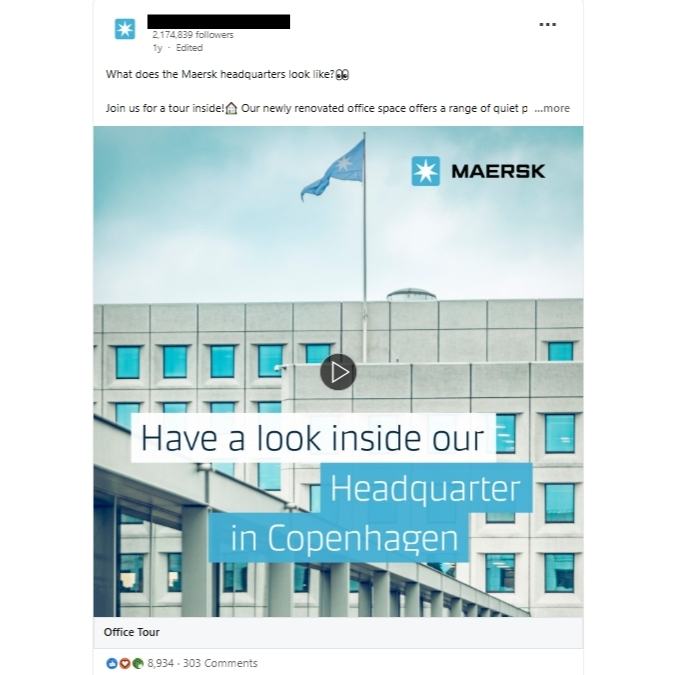
This works especially well for remote creators, freelancers, or small teams. People are naturally curious about how others work, so show them your desk setup, your tools, your coffee stash, whatever.
Doesn’t have to be fancy. In fact, a raw and real look performs better than a super-polished one.
Pro Tip: Use a mix of photo + caption or a video walkthrough.
Example:
“👀 My actual home office setup:
- MacBook Air M2
- Logitech MX Keys
- Ikea standing desk
- 2 plants (both real)
- 1 dog occasionally snoozing under the table
It’s simple, but it works.”
25. Host or Share Snippets from a LinkedIn Live Session
If you’re hosting Lives, don’t let that content die after the broadcast. Chop it up into clips, turn it into carousels, or pull 3 key quotes for a text post.
Even if you didn’t host it, you can share highlights from a session you attended, especially if it was valuable to your niche.
Pro Tip: Clip a 15 – 30 sec snippet with a juicy moment and add a CTA like “Full replay in comments.”
Example:
“🔥 Best 20 seconds from last night’s Live:
‘Stop chasing reach. Start chasing resonance.’
We had 200+ marketers join our session on personal branding, insane energy.
Full replay link in comments 👇”
26. Launch a LinkedIn Newsletter
If you’ve got a consistent perspective, teachable skills, or industry commentary, a LinkedIn Newsletter is a no-brainer. It not only builds loyalty, but also gives your best ideas a home that people can subscribe to (and get notified about directly).
Plus, it positions you as a trusted source, especially when you stick to a regular rhythm (weekly or bi-weekly is ideal).
Pro Tip: Start with a post introducing your newsletter. Share who it’s for, what topics you’ll cover, and why now.
Example:
“Excited to launch my LinkedIn Newsletter: The Marketing Playbook 🎯
I’ll be sharing one actionable idea every week on how to grow your business using content, ads, and automation.
If you’re a freelancer, creator, or marketer looking to work smarter, this is for you.
First issue drops Friday. Want in? Hit the ‘Subscribe’ button on my profile.”
27. Summarize Key Learnings from Industry Reports
Not everyone has time to read 60-page PDF reports, but they will read your quick breakdown. Pick a recent industry study (from places like HubSpot, McKinsey, Adobe, etc.) and pull 3 – 5 insights that are relevant to your audience.
Add your commentary. Don’t just repeat stats, tell us what they mean.
Pro Tip: Use a carousel or visual slides if you’re summarizing a dense report.
Example:
“📉 Key insights from HubSpot’s 2024 State of Marketing Report:
- 67% of marketers say short-form video drives the highest ROI
- Email open rates have dropped 12% YoY
- 49% of B2B buyers now research via social media
My take? If you’re still ignoring video + LinkedIn, you’re leaving leads on the table.”
28. Share a Monthly Recap or “Top 5 Learnings This Month”
This one’s perfect for solo creators or agency founders, and it’s incredibly relatable. Recap your month, reflect on what worked, what didn’t, and what you’re carrying forward. It humanizes you while still delivering real value.
Even better if you share real numbers, mistakes, or mindset shifts.
Pro Tip: Use a repeatable format so you can build a monthly habit, and followers know what to expect.
Example:
“📅 May Recap: 5 Things I Learned This Month
- Posting carousels twice a week doubled my profile visits
- Offering a free audit got me 3 high-ticket clients
- Batch-creating content is still hard (but necessary)
- No one cares how often you post, they care what you say
- Never launch on a Monday (trust me)
What’s one thing you learned in May?”
29. Share Third-Party Content With Insights
Curated content is underrated on LinkedIn, but it works only if you add context. Don’t just drop a link. Tell us why it matters, what stood out, and how we should apply it.
Think of it as “news + your brain.”
Pro Tip: Tag the original author or publication for extra reach and credibility.
Example:
“This article by @NeilPatel breaks down how AI is transforming SEO, and it’s a must-read if you create content.
One stat that stood out: 44% of top-ranking pages are now using AI-generated outlines.
My take? The game is changing, fast. But strategy still beats speed.”
30. Collaborate with Influencers or Industry Leaders
If you want to expand your reach and build authority, collabs are your best friend. Whether it’s a co-written post, a joint Live, or simply tagging someone in a shared discussion, this builds credibility by association.
Bonus: Their audience sees your content too, which brings new eyes to your profile.
Pro Tip: Don’t wait for collabs to “happen.” Reach out with a simple pitch and clear value.
Example:
“Just wrapped up a mini collab with @Aditi Verma on how brands can repurpose reels into high-performing LinkedIn content.
We brainstormed 3 content flows you can steal, and Aditi brought some wild insights from her last campaign.
Full post coming tomorrow, make sure to follow both of us to catch it”
Also Read: Difference between Content Creator and Influencer
Pro Tips for Writing High-Engagement LinkedIn Posts
- Hook your audience in the first 2 lines
Most people scroll fast, if your first two lines don’t grab attention, they won’t read the rest. Ask a question, share a bold statement, or open with a relatable moment. - Use whitespace and emojis for readability
Don’t write huge chunks of text. Break your post into short lines. A little white space makes it feel breathable. Emojis help too, but use them intentionally, not like confetti. - Add a strong CTA (comment, share, tag someone)
Want engagement? Ask for it. Invite people to comment, tag a friend, or share their thoughts. Just don’t force it, keep your CTA aligned with the post’s tone and value. - Use relevant hashtags (but don’t overdo it)
Hashtags help with discoverability, but stick to 3 – 5 focused ones. Mix niche tags with broader ones like #LinkedInTips or #ContentMarketing. Avoid cluttering the end of your post with 20 random ones.
Conclusion: Keep Showing Up
You don’t need to go viral to make an impact. The creators and professionals who win on LinkedIn are the ones who show up consistently, even when the likes are low or the algorithm feels off.
With over 1 billion members on the platform, your next client or opportunity could literally be one post away. But here’s the thing—most people give up after a few weeks when they don’t see instant results.
Mix up your content formats. Try new ideas. Track what connects. Most importantly, stay real. People follow people who are helpful, honest, and human.
Start with one idea from this list. Post it tomorrow. Then pick another next week. Before you know it, you’ll have your own system that works.
FAQs: LinkedIn Post Ideas
1. How often should I post on LinkedIn to stay visible?
Aim for 2 – 4 posts a week. That’s enough to stay top-of-mind without burning out. Consistency beats volume, so find a rhythm that works for you and stick to it as much as possible.
2. What type of content performs best on LinkedIn?
Content that feels personal, helpful, or insightful usually gets the most traction. Think personal stories, how-tos, carousels, and opinion posts. Posts that sound like a human always win over corporate fluff.
3. Are videos more effective than text posts on LinkedIn?
Short videos can grab attention, especially when they’re practical or behind-the-scenes. But well-written text posts still dominate LinkedIn if they have a hook and tell a good story. It’s not either/or, mix both in.
4. What is the ideal length of a LinkedIn post?
150 – 300 words tends to hit the sweet spot. Long enough to tell a story or teach something, but short enough to stay skimmable. Break it into short paragraphs and add a clear CTA at the end.
5. Can I promote my business directly on LinkedIn?
Yes, absolutely, but do it in a way that adds value. If all your posts sound like ads, people tune out. Mix self-promotion with insights, case studies, stories, or tips that help your audience too.
6. How do I know what my LinkedIn audience wants to see?
Check your analytics to see what’s getting reach and reactions. Also, try polls or ask questions directly in posts. Pay attention to comments, they’re gold for figuring out what resonates.
